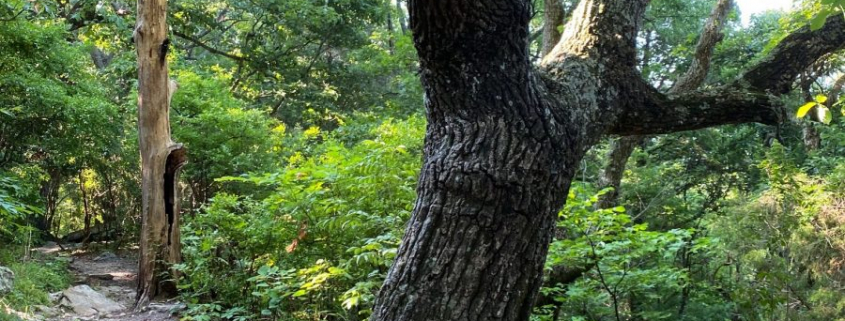Mid-July Circuit of the Rainbow Mountain Loop Trail
July 17, 2022, I hiked the Rainbow Mountain Loop Trail at Madison, Alabama’s Rainbow Mountain Nature Preserve. My intent was not to rush from start to finish, but to proceed slowly and deliberately…with eyes wide open, searching for what lay hidden in plain sight. This Post offers observations, reflections, and photographs from my three-hour stroll. My trek began at 1,100 feet, dropped to 750, then returned. The Preserve sits in the center of Madison, surrounded by subdivisions. The terrain is rocky, steep, and forested. Except for the traffic sounds and an occasional emergency vehicle siren, I could have been in rural wildland.
The Harsh Summit
The summit microsite is harsh. Soils are shallow, bedrock often at the surface, and the chestnut oak and eastern red cedar forest is scrubby, expressing the poor site quality.
Coarse-limbed chestnut oak trees dominate the summit plateau and rimrock edges. Desiccated resurrection fern carpeted most branches. I’ve walked these trail during wetter periods when the resurrection fern is lush and deep green. Temperature well into the 90s assure the scalded look. Cedar co-occupies this upland forest. The tree below right is one of the North Alabama Land Trust’s Hug Me! trees.
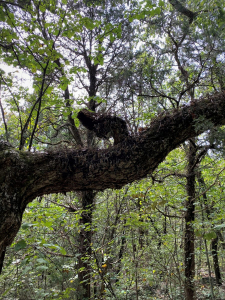
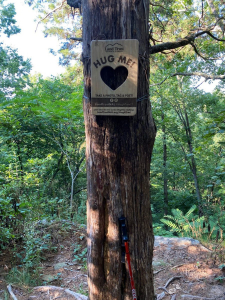
Just as the fern secures acceptable anchorage and nutrition on tree branches, lichens find safe harbor on exposed rock surfaces. I’ve often repeated the old wisdom that Nature Abhors a Vacuum. Imagine eaking out an existence on a bare rock. This crustose lichen requires little…and finds plenty of it on Rainbow Mountain!
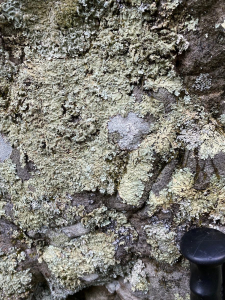
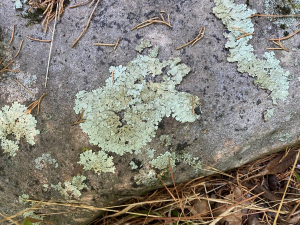
Lichen appeared dry and drab on this mid-summer day. However, during the wet and cool dormant season, I’ve seen colorful lichen palettes on these harsh surfaces. The resurrection ferns below right, now seeming lifeless, also become vibrant during those periods.
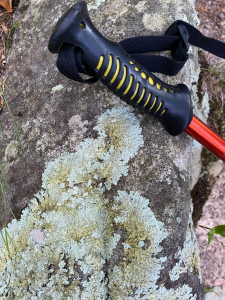
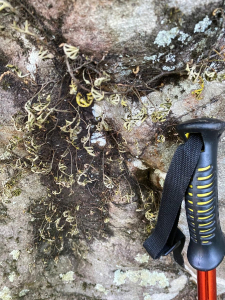
Appearing similar to resurrection fern, ebony spleenwort, another fern, does not dessicate. It has found sufficient sustenance in the rock fissure below left. It deals with dry conditions by simply shutting down respiration when moisture is limited. Below right a dusty mullein grows from a crack in the exposed ledge. Any port in a storm, I suppose.

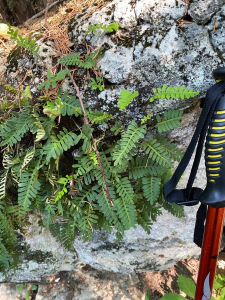
A prickly pear seems right at home along the rimrock.
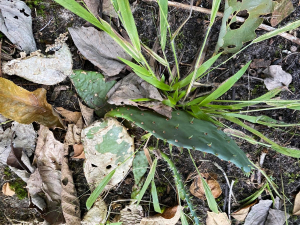
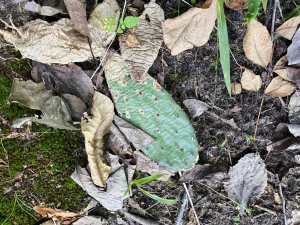
I caught leafcup in full flower. Yet its seasonal growth window is closing. Below right, even as the leafy tops are flowering, the stems are desiccating from the base. They will soon pass into senescence unless rains appear within a few days of my ramble.
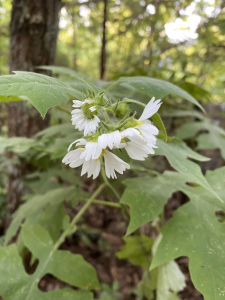
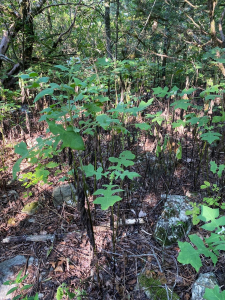
Whitemouth dayflower provided some mid-summer blue and yellow. The bright color seemed to belie the harsh dryness that otherwise prevailed.
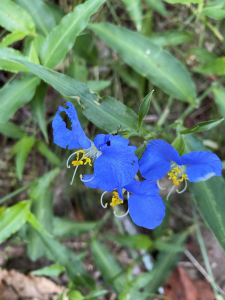
Summit Forest
When hiking, I’m obsessed with the subtle hidden beauty and magic around me. I often forget to capture a few minutes of video. This day I remembered. Although I don’t relish the sound of my own voice, I’m convinced that the video images tell a worthy tale, even if mingled with my voice! Here’s the first of two videos within this Post, this one (3:11) recorded in the harsh near-summit forest: https://www.youtube.com/watch?v=GQ1sJiByseQ&t=3s
This 30-inch diameter chestnut oak is growing amid the rimrock. Given its size and likely slow growth, the oak may be older than two centuries. On such shallow soil and harsh exposure, it must be tapping some soul-spring of vitality…securing moisture and nutrients otherwise hidden and unavailable. Sometimes success boils down to simply showing up…in the right spot! There are very few right spots atop Rainbow Mountain. Although of considerable girth, this individual reaches only fifty feet vertical.
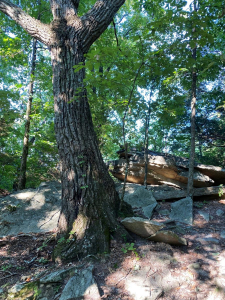
Evidencing the limited surface soil, this ash (I don’t know whether it is white or green ash) has toppled over, tipping from the bare rock on which it had found purchase. The photo below left shows the tree lifting from the rock and leaning 45 degree to the right, dislodging virtually no roots from that downhill, rock-surface side. The tree is leaning to the uphill side, where its roots are still secure, furnishing moisture, nutrients, and some semblance of anchorage. The tree remains very much alive.
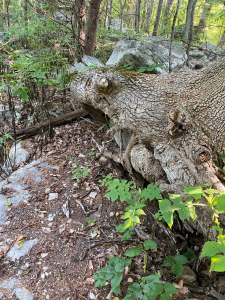
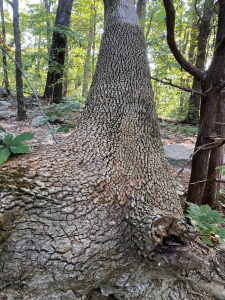
Another coarse old chestnut oak stands sentry at the rimrock. Beyond it in the first photo (and close up in the second) stands the skeleton of long-deceased tree of the same species. Nothing in Nature is static.
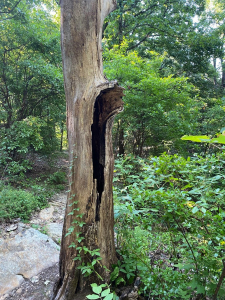

Nearby stands a gnarled, deformed, still-living cedar. Covered in dried resurrection fern, the tree presents a different mood during wetter days.
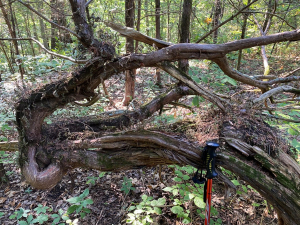
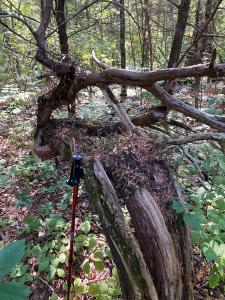
From March 2020, the tree bears vibrant resurrection fern.
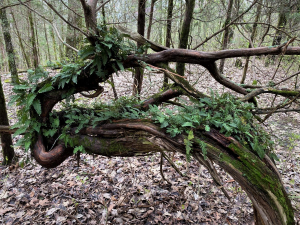
Eastern red cedar is a tree of deep character in our northern Alabama forests. A pioneer species, it is among the first, courtesy of bird seed-dispersion, to invade/occupy severely disturbed land (wildfire; abandoned agriculture; blowdown). Most of our regional forests naturally regenerated following disturbance. Cedar in many of our forests remains as scattered residuals, only seldomly reaching into the main canopy. Those cedar remaining, like the fern-cloaked individual above, often tell a tale in their form, bark, and disfigurement…as I term it, their character. This one appears to have a branch-stub pipe exiting its main trunk three feet above the ground.
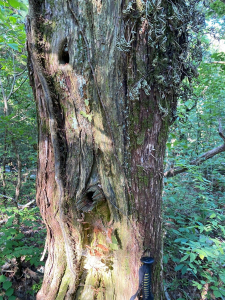
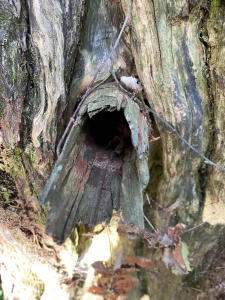
And its two eyes (with subtle nose) gaze down from twelve feet above!
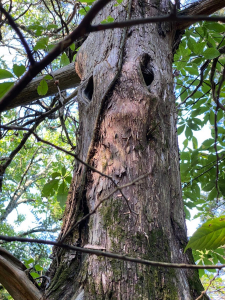
Because cedar wood is naturally decay resistant, its trunk and branches persist long after death, standing guard along forest paths.
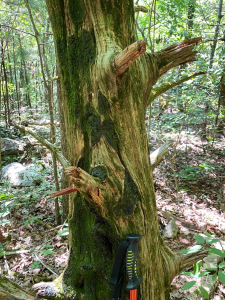
I could not identify the species of this fallen tree and what I referred to as its driftwood root mass.
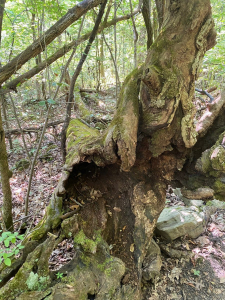
Dead and down woody debris serve as further reminder that nothing in Nature is static.
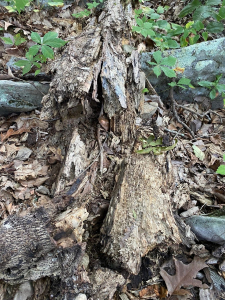
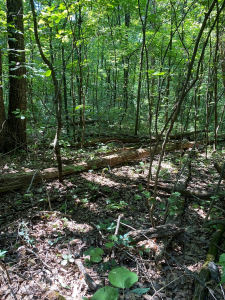
My wanderings brought me down to the 750 foot elevation of the spring. I offer this 1:32 video to introduce the better site quality below the harsh summit: https://www.youtube.com/watch?v=PwKEiU6rQek
Interesting forest Features
Always on the lookout for tree form oddities and curiosities, I found this hickory turtle-head-burled-branch near the trail.
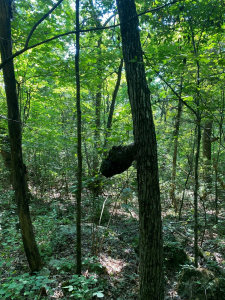
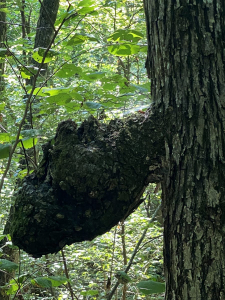
A black knot of cherry engulfing this four-inch diameter black cherry drew my attention.
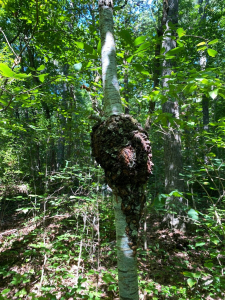
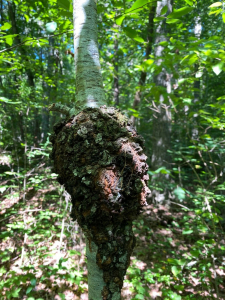
One might wonder how forest cover sustains on this 400-foot rock pile in the heart of Madison. As I returned to the summit and parking lot, traversing the Wild Trail, I photographed this deep fracture in the limestone. Somehow, our climate slowly weathers bare rock to soil worthy of supporting varied forest ecosystems.
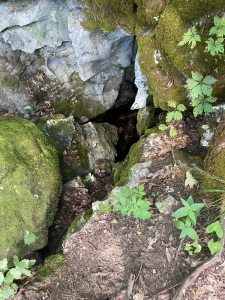
Along that same Wild Trail I encountered what for me is a new species, fragrant sumac. At first, I identified it as poison oak. Further reference examinations convinced me that this is fragrant sumac. I remain unable to confidently distinguish poison ivy from poison oak. They both contain the same toxic resin, urushiol, to which I am most assuredly allergic. I may never venture a close botanical examination to distinguish the two equally skin-toxic species!
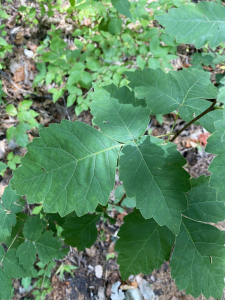
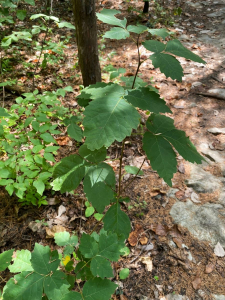
I enjoyed my three-hour stroll. Four months beyond my March 23 stroke, I felt fairly secure and steady even on the steep and rocky trail pitches. My stroke-induced instability has abated. I have now returned to the new baseline of weakness attributable alone to having bone on bone in both knees. Once my replaced shoulder is at full strength, I will consider knee replacement in my progress toward achieving the dubious distinction of bionic naturalist!
Thoughts and Reflections
I offer these observations:
- Wild places reveal new secrets every time we visit; their mysteries lie hidden in plain sight.
- Sometimes wildness lies where one might least expect to find it.
- Walking in the forest rewards far more than walking through the forest. Wander patiently…and with purpose!
Inhale and absorb Nature’s elixir. May Nature Inspire, Inform, and Reward you!
Note: All blog post images created & photographed by Stephen B. Jones unless otherwise noted. Please circulate images with photo credit: “©2022 Steve Jones, Great Blue Heron LLC. All Rights Reserved.”
Another Note: If you came to this post via a Facebook posting or by an another route, please sign up now (no cost… no obligation) to receive my Blog Post email alerts: http://eepurl.com/cKLJdL
And a Third: I am available for Nature-Inspired Speaking, Writing, and Consulting — contact me at steve.jones.0524@gmail.com
Reminder of my Personal and Professional Purpose, Passion, and Cause
If only more of us viewed our precious environment through the filters I employ. If only my mission and vision could be multiplied untold orders of magnitude:
Mission: Employ writing and speaking to educate, inspire, and enable readers and listeners to understand, appreciate, and enjoy Nature… and accept and practice Earth Stewardship.
Vision:
- People of all ages will pay greater attention to and engage more regularly with Nature… and will accept and practice informed and responsible Earth Stewardship.
- They will see their relationship to our natural world with new eyes… and will understand more clearly their Earth home.
Tagline/Motto: Steve (Great Blue Heron) encourages and seeks a better tomorrow through Nature-Inspired Living!
Steve’s Three Books
I wrote my books Nature Based Leadership (2016), Nature-Inspired Learning and Leading (2017), and Weaned Seals and Snowy Summits: Stories of Passion for Place and Everyday Nature (2019; co-authored with Dr. Jennifer Wilhoit) to encourage all citizens to recognize and appreciate that every lesson for living, learning, serving, and leading is either written indelibly in or is powerfully inspired by Nature.
I began writing books and Posts for several reasons:
- I love hiking and exploring in Nature
- I see images I want to (and do) capture with my trusty iPhone camera
- I enjoy explaining those images — an educator at heart
- I don’t play golf!
- I actually do love writing — it’s the hobby I never needed when my career consumed me
- Judy suggested my writing is in large measure my legacy to our two kids, our five grand kids, and all the unborn generations beyond
- And finally, perhaps my books and Blogs could reach beyond family and touch a few other lives… sow some seeds for the future

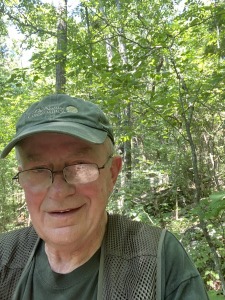
All three of my books (Nature Based Leadership; Nature-Inspired Learning and Leading; Weaned Seals and Snowy Summits) present compilations of personal experiences expressing my (and co-author Dr. Wilhoit for Weaned Seals and Snowy Summits) deep passion for Nature. All three books offer observations and reflections on my relationship to the natural world… and the broader implications for society. Order any and all from your local indie bookstore, or find them on IndieBound or other online sources such as Amazon and LifeRich.

